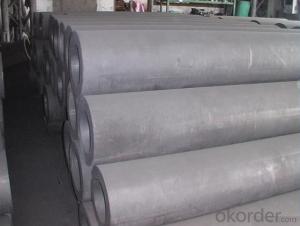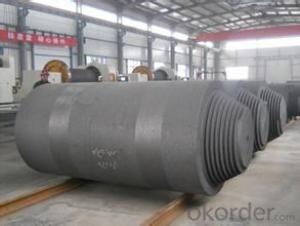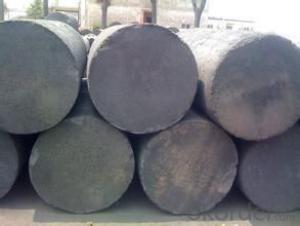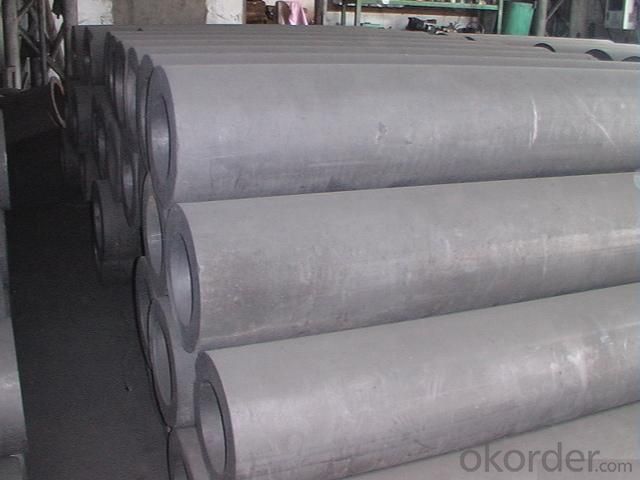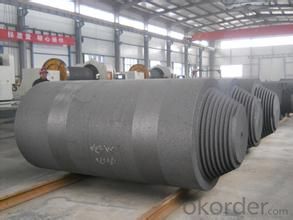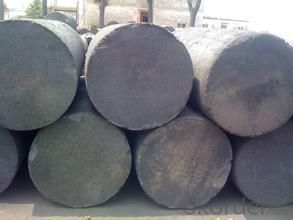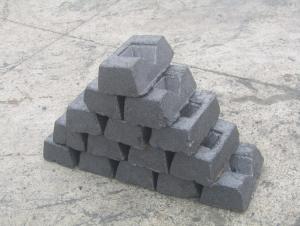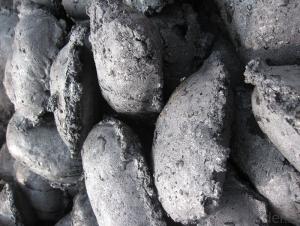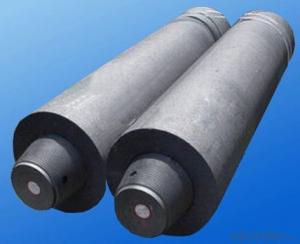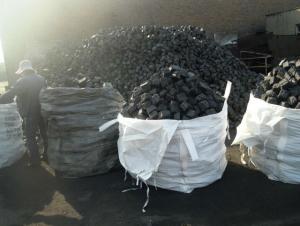Carbon Electrode With For Silicon Metal and Ferroally Production
- Loading Port:
- Tianjin
- Payment Terms:
- TT or LC
- Min Order Qty:
- 20 m.t.
- Supply Capability:
- 800 m.t./month
OKorder Service Pledge
OKorder Financial Service
You Might Also Like
Product Description
Carbon Electrode is abaked electrode used in submerged arc furnaces for delivering power to the charge mix. Electrode is added to the top of the electrode column cylindrical form. Electrode is essentially a mix of Electrically Calcined Anthracite (ECA) or Calcined Petroleum Coke (CPC) with Coal Tar Pitch and is baked for weeks, it is widly used for ferroally productiong, silicon metal production etc.
Carbon Electrode Specification:
PARAMETER UNIT GUARANTEE VALUE Ash.( % ) 4.0 max 5.0 max 6.0 max 7.0 max 9.0 max 11.0 max V.M (%) 12.0-15.5 12.0-15.5 12.0-15.5 9.5-13.5 11.5-15.5 11.5-15.5 Compress Strength. (Mpa) 18.0 min 17 min 15.7 min 19.6 min 19.6 min 19.6 min Specific Resistance (μΩm) 65 max 68 max 75 max 80 max 90 max 90 max Bulk Density (G/CM3) 1.38 min 1.38 min 1.38 min 1.38 min 1.38 min 1.38 min PACKAGE: The cargo is packaged on pallets.
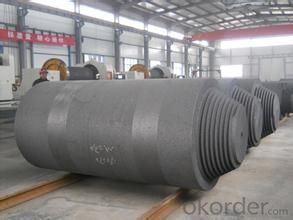
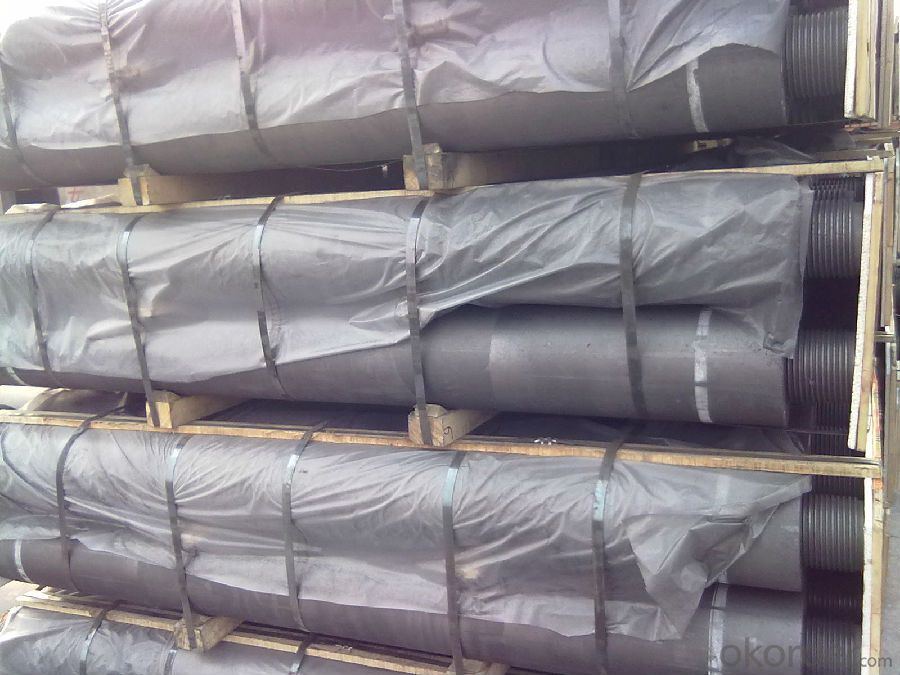
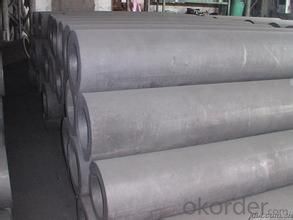
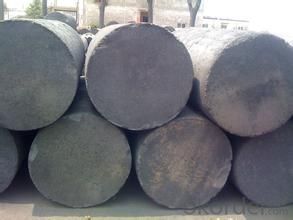
We Also supply all kind of carbon electrode paste and below materials, please contact us if you have any enquiry about it.
Calcined Anthracite
Calcined Petroleum Coke
Coke (Met Coke, Foundry Coke, Semi Coke)
- Q: There is a graphite mine, looking for three experts engaged in mineral processing industry asked. They say earthy graphite, and the answer to the taste is quite different. Some say that the fixed carbon content of 15, and some say graphite grade 90%. The same sample. Some people say that very valuable, and some say that the grade is too low, worthless. I'm all confused. What do you mean by graphite grade and fixed carbon?
- The taste of graphite powder refers to its purity, that is, the amount of carbon; fixed carbon content refers to the removal of water, ash and volatile residues, it is an important indicator of the use of coal. The two are essentially different
- Q: What are the impacts of carbon emissions on glacier retreat?
- The impacts of carbon emissions on glacier retreat are significant and alarming. As carbon dioxide and other greenhouse gases are released into the atmosphere, they trap heat and contribute to global warming. This rise in temperature directly affects glaciers by accelerating their melting and retreat. Glaciers act as natural reservoirs of freshwater, and their retreat has severe consequences for water availability, ecosystems, and human populations that depend on them. Additionally, the melting of glaciers contributes to rising sea levels, which poses a threat to coastal communities. Overall, carbon emissions play a major role in driving glacier retreat and exacerbating the impacts of climate change.
- Q: What are the effects of carbon emissions on the stability of estuaries?
- Carbon emissions have significant effects on the stability of estuaries. Increased carbon dioxide in the atmosphere leads to ocean acidification, which negatively impacts the delicate balance of estuarine ecosystems. Acidic waters can harm the growth and survival of estuarine plants and animals, disrupt the food web, and reduce biodiversity. Additionally, carbon emissions contribute to global warming, leading to rising sea levels and increased storm intensity, which can cause erosion and flooding in estuaries. Overall, carbon emissions pose a threat to the stability and health of estuaries, with potentially far-reaching ecological consequences.
- Q: How is carbon used in the agricultural industry?
- Various purposes in the agricultural industry make carbon widely used. One of its main uses in agriculture is as a soil amendment. The addition of carbon-rich organic matter, like compost or manure, improves soil structure, fertility, and overall health. This occurs because carbon increases the soil's capacity to retain moisture, nutrients, and beneficial microorganisms, all of which are vital for plant growth. In addition to soil amendment, carbon is also utilized in the form of carbon dioxide (CO2) for greenhouse enrichment. In controlled environments such as greenhouses, plants require higher concentrations of CO2 to enhance growth and productivity. Carbon dioxide is introduced into the greenhouse to maintain optimal levels, facilitating photosynthesis and accelerating plant growth. Furthermore, carbon-based fertilizers are commonly employed in agriculture. Fertilizers like urea or ammonium nitrate provide essential nutrients to crops and enhance productivity. Carbon serves as a crucial component in these fertilizers, aiding in the controlled release and effective uptake of nutrients by plants. Moreover, carbon is employed in the production of pesticides and herbicides. Many of these agricultural chemicals contain carbon compounds specifically designed to target and control pests, diseases, and weeds that can harm crops. Carbon-based chemicals are preferred due to their effectiveness and ability to naturally break down without causing long-term harm to the environment. In summary, carbon plays a vital role in the agricultural industry by enhancing soil fertility, promoting plant growth, and aiding in pest control. Its versatility makes it an indispensable resource for sustainable and efficient farming practices.
- Q: How does carbon dioxide affect textile production?
- Carbon dioxide can have various impacts on textile production. Firstly, the production of carbon dioxide during the manufacturing process of textiles contributes to the overall greenhouse gas emissions, which exacerbates climate change. This can lead to long-term consequences such as extreme weather events, rising temperatures, and sea-level rise, all of which can disrupt the supply chain and production of textiles. Moreover, carbon dioxide emissions from textile production contribute to air pollution, which can have adverse effects on human health. The release of this greenhouse gas can lead to respiratory problems and other respiratory diseases in workers exposed to high levels of carbon dioxide. Additionally, carbon dioxide is often used as a part of the dyeing and finishing process in textile production. This can have negative consequences for the environment as well. Carbon dioxide can contribute to water pollution when it is released into water bodies during the dyeing process, leading to the contamination of water sources and harming aquatic life. Furthermore, the excessive use of carbon dioxide in textile production can also have economic implications. As carbon dioxide is a byproduct of burning fossil fuels, its production is inherently linked to the consumption of non-renewable resources. The reliance on fossil fuels can make textile production vulnerable to price fluctuations, as the cost of carbon dioxide emissions and energy production can vary significantly. To mitigate the negative impacts of carbon dioxide on textile production, various measures can be taken. These include adopting cleaner production techniques and technologies that reduce carbon dioxide emissions, such as the use of renewable energy sources or implementing carbon capture and storage systems. Additionally, investing in sustainable and environmentally-friendly materials, such as organic cotton or recycled fibers, can also help reduce the carbon footprint of textile production. Overall, the reduction of carbon dioxide emissions in textile production is crucial for the industry to become more sustainable and mitigate its environmental and health impacts.
- Q: Organic matter is converted from organic carbon. Why is humus represented by carbon instead of converted?
- Soil organic matter refers to all organic matter in the soil, due to the size of the organic matter content of different soil in a composition is more complex, but are not necessarily organic carbon containing material, so there is a mathematical relationship between soil organic matter and organic carbon. In general, we are the first to measure the content of soil organic carbon, and then use the formula to convert the content of organic matter.
- Q: How do humans contribute to carbon emissions?
- Humans contribute to carbon emissions through various activities, such as burning fossil fuels for electricity, transportation, and heating; deforestation and land-use changes; industrial processes; and the production and disposal of waste. These actions release significant amounts of carbon dioxide and other greenhouse gases into the atmosphere, exacerbating the greenhouse effect and contributing to climate change.
- Q: What are the impacts of carbon emissions on the stability of grasslands?
- Carbon emissions have significant impacts on the stability of grasslands. As carbon dioxide (CO2) is released into the atmosphere, it contributes to the greenhouse effect, leading to global warming. This increase in temperature has several detrimental effects on grasslands. Firstly, higher temperatures can disrupt the balance of grassland ecosystems. Many grassland species have specific temperature requirements for growth and reproduction. As temperatures rise, these species may struggle to adapt, leading to a decline in their populations. This can disrupt the overall biodiversity and ecological stability of grasslands. Secondly, global warming can alter precipitation patterns, leading to changes in water availability in grasslands. Reduced rainfall or increased evaporation can result in drought conditions, making it difficult for grasses to grow and thrive. This can lead to the desertification of grasslands, transforming them into barren areas devoid of plant life. Furthermore, carbon emissions contribute to the acidification of the oceans, which can indirectly impact grasslands. Acidic ocean waters affect marine organisms, including those responsible for generating nutrients that are carried by winds to coastal and inland grasslands. If these nutrient sources decline, grasslands may experience reduced fertility and productivity, affecting the stability of these ecosystems. Lastly, carbon emissions can also exacerbate the frequency and intensity of wildfires. Grasslands are naturally adapted to periodic fires, which play a crucial role in maintaining biodiversity and regulating plant populations. However, the increase in carbon dioxide levels can fuel more intense and frequent wildfires, which can destroy grasslands and make their recovery more challenging. In conclusion, carbon emissions have multiple negative impacts on the stability of grasslands. They disrupt the balance of grassland ecosystems, alter precipitation patterns, contribute to ocean acidification affecting nutrient sources, and increase the risk of wildfires. These effects can lead to biodiversity loss, desertification, reduced fertility, and overall instability in grassland ecosystems. It is crucial to reduce carbon emissions and mitigate the impacts of global warming to ensure the long-term stability and preservation of grasslands.
- Q: How does carbon dioxide affect the acidity of rainwater?
- Carbon dioxide (CO2) dissolves in rainwater to form carbonic acid (H2CO3), which increases the acidity of the rainwater.
- Q: What is a carbon electrode? What's the use? What's the current situation in the industry? Try to be specific. Thank you
- Tons of ferrosilicon smelting costs reduced by 300-400 yuan, tons of calcium carbide smelting costs reduced by more than 100 yuan.Carbon electrode is an energy saving and environmental friendly product. It can greatly reduce power consumption and reduce pollution in the use of calcium carbide and ferroalloy ore heating furnaces. It is the replacement product of electrode paste. In the submerged arc furnace with the same capacity, electrode paste self baking electrode compared with the following characteristics: improving smelting furnace production, reduce power consumption and reduce the labor intensity (15-20%; 1 tons of iron smelting alloy consumption of electrode paste carbon electrode about 60kg, consumption is only about 12kg, reduce the operating times of the electrode), simplified production process; to avoid or reduce the self baking electrode frequent "broken soft" and "hard" accidents, improve the working environment, reduce operating costs.
Send your message to us
Carbon Electrode With For Silicon Metal and Ferroally Production
- Loading Port:
- Tianjin
- Payment Terms:
- TT or LC
- Min Order Qty:
- 20 m.t.
- Supply Capability:
- 800 m.t./month
OKorder Service Pledge
OKorder Financial Service
Similar products
Hot products
Hot Searches
